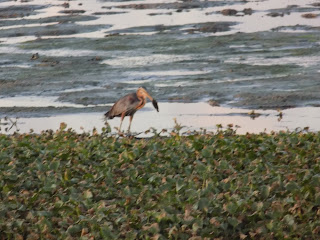Peltophorum pterocarpum (commonly known as copperpod, yellow-flamboyant, yellow flame tree, yellow poinciana or yellow-flame). this plant is very common in most areas of Chennai, in some places it grew as an avenue tree. inside Chennai Forest areas (Like IIT, Guindy National Park, Arignar Anna Zoological Park, Nanganallur Reserve forest) also this tree has a wide distribution. A very common tree in Chennai.
Wetlands are one of the most important freshwater sources. They also provide various ecological services. India is extremely rich in terms of wetland diversity and is one of the few countries in the world to have a wetland inventory system. There are 42 sites in the country that have been designated as Wetlands of International Importance or Ramsar sites. Here we are trying to explore Chennai's Wetland Biodiversity...Anyone can contribute to this...
Peltophorum pterocarpum / copperpod பெருங்கொன்றை Chennai Wetland Biodiversity | Plants of Perumpakkam marshland | Trees of Chennai city
Leptotes plinius plinius (Fabricius, 1793) – Asian Zebra Blue (வரிக்குதிரை நீலன்) | | Chennai wetland area | Butterflies of Madipakkam & Medavakkam Marshlands, Chennai city wetlands biodiversity
Lepidoptera > Papilionoidea > Lycaenidae > Polyommatinae > Polyommatini > Leptotes.
Scientific classification
The Purple Heron (Ardea purpurea) செந்நாரை | Chennai wetland area | Birds of Perumbakkam & Medavakkam Marshlands, Chennai city birds
Purple Heron செந்நாரை
Purple heron is one of the most confusing heron, and most similar to the grey heron. There are some noticeable differences which helps in the identification. this birds have been observed at Perumbakkam and Medavakkam wetland areas (we have not visited Pallikaranai marshland).
The Rose-ringed Parakeet (Psittacula krameri) பச்சைக்கிளி | Chennai wetland area | Birds of Medavakkam Marshlands, Chennai city birds
Scientific classification
Paddyfield Pipit (Anthus rufulus) நெல்வயல் நெட்டைக்காலி Chennai wetland area | Birds of Perumbakkam Marshlands, Chennai city birds
நெல்வயல் நெட்டைக்காலி (paddyfield pipit, அல்லது Oriental pipit, (Anthus rufulus) என்பது ஒரு சிறிய பாசரிபாரம்சு பறவை ஆகும். இது வாலாட்டிக் குருவிக் குடும்பத்தைச் சேர்ந்த பறவை ஆகும். இவை ஒரு பகுதியிலேயே வாழக்கூடியன (வலசை போகாதவை) இவை திறந்த வெளிகளிலும், புல்வெளிகளிலும் வாழக்கூடியன, தெற்கு ஆசியா, கிழக்குப் பிலிப்பீன்சு போன்ற பகுதிகளில் உள்ளன. பிற மற்ற இனங்கள் ஆசியாவின் பிற பகுதியில் காணப்படுகின்றன. ஆசிய பிராந்தியத்தில் குளிர்காலத்தில் இவ்வகைப் பறவைகளை அடையாளம் காண்பது கடினமாக இருக்கும். இனங்களின் வகைப்பாட்டில் சிக்கலான மற்றும் கணிசமான மாற்றங்கள் ஏற்பட்டிருக்கின்றன.
Black Drongo (Dicrurus macrocercus) இரட்டைவால் குருவி
வெண்புருவ வாலாட்டி White-browed Wagtail
Pied Bushchat (Saxicola caprata) புதர்ச்சிட்டு
Purple-rumped Sunbird Leptocoma zeylonica ஊதாப்பிட்டத் தேன்சிட்டு
Eurasian Moorhen Gallinula chloropus தாழைக் கோழி
Bronze winged Jacana (Metopidius indicus) தாமிர இறக்கை இலைக்கோழி
White-breasted waterhen (Amaurornis phoenicurus) வெள்ளை நெஞ்சு நீர்க்கோழி
The greater flamingo (Phoenicopterus roseus) பெரும் பூநாரை
Indian spot-billed duck (Anas poecilorhyncha) புள்ளி மூக்கு வாத்து
The glossy ibis (Plegadis falcinellus) அன்றில் Chennai wetland area | Birds of Medavakkam Marshlands, Chennai city birds
Read More about Glossy ibis here
Black Drongo (Dicrurus macrocercus) இரட்டைவால் குருவி
வெண்புருவ வாலாட்டி White-browed Wagtail
Pied Bushchat (Saxicola caprata) புதர்ச்சிட்டு
Purple-rumped Sunbird Leptocoma zeylonica ஊதாப்பிட்டத் தேன்சிட்டு
Eurasian Moorhen Gallinula chloropus தாழைக் கோழி
Bronze winged Jacana (Metopidius indicus) தாமிர இறக்கை இலைக்கோழி
White-breasted waterhen (Amaurornis phoenicurus) வெள்ளை நெஞ்சு நீர்க்கோழி
The greater flamingo (Phoenicopterus roseus) பெரும் பூநாரை
Indian spot-billed duck (Anas poecilorhyncha) புள்ளி மூக்கு வாத்து
The greater flamingo (Phoenicopterus roseus) பெரும் பூநாரை Chennai Wetland Birds Perumbakkam Marshland birds || Bird watching





Indian spot-billed duck (Anas poecilorhyncha) புள்ளி மூக்கு வாத்து அல்லது புள்ளி மூக்கன் Chennai Wetland Birds Perumbakkam Marshland birds || Bird watching
Indian spot-billed duck
Scientific classification
Kingdom: Animalia
Phylum: Chordata
Class: Aves
Order: Anseriformes
Family: Anatidae
Genus: Anas
Species: A. poecilorhyncha
Binomial name: Anas poecilorhyncha Forster, 1781
A large grayish-brown duck with a diagnostic yellow-tipped black bill and a red spot at the base of the bill (missing in certain subspecies). In-flight, note the green panel in the wing that is bordered in white. Often seen in small groups dabbling or tipping up in shallow water or walking on marshy land at the edge of freshwater lakes or in cultivated fields. Usually not seen associating with other species. Similar to Eastern Spot-billed Duck, but note green wing panel, lack of a distinct dark "moustache", and overall warmer tan coloration (Source Ebirds).
Black-winged stilt (Himantopus himantopus) நெடுங்கால் உள்ளான் Chennai Wetland Birds Perumbakkam Marshland birds || Bird watching
Scientific classification
Kingdom: Animalia
Phylum: Chordata
Class: Aves
Order: Charadriiformes
Family: Recurvirostridae
Genus: Himantopus
Species: H. himantopus
Binomial name: Himantopus himantopus (Linnaeus, 1758)
Grey Heron (Ardea cinerea) சாம்பல் நாரை Chennai Wetland Birds Medavakkam & Perumbakkam Marshland birds || Bird watching



Scientific classification
Birds of Annakkili Amma Research Institute | April observation published on World Big Day of Ebird
On the day of "World Big Day" I would like to share the list of birds, I observed during the month of April 2021.
Common Name: Rock Pigeon
Scientific Name: Columba Olivia (Columbiformes > Columbidae)
Around Annakkili Amma Research Institute (AARI) we could observe more Feral pigeons... Here we are sharing the group photo of a small group of feral pigeon at the backside of AARI
Common Name: Asian Koel
Around Annakkili Amma Research Institute (AARI) we could observe at least 4, Asian Koels, every day and someday at a certain time we have even observed more than 10 Asian koels... Here is the link for a small write-up on Asian Koel from us. Follow the link to see more photos.
Common Name: Asian Palm-Swift
Common Name: Eurasian Moornhen
Scientific Name: Gallinula chloropus (Gruiformes > Rallidae)
Black-headed Ibis
Indian Roller
Rose-ringed Parakeet
House Crow
Common Tailorbird
Yellow-billed Babbler
Purple Sunbird
AARI World Wetland Day Quiz, 2022 conducted by AARI and Chennai Wetlands Biodiversity Blog || Publish your articles and books with us www.aaribioscience.com
Annakkili Amma Research Institute (AARI) Chennai Wetland Biodiversity Blog wishes you all Happy World Wetland Day 2022 AARI organizes vari...

-
Annakkili Amma Research Institute (AARI), organizes various quiz and webinar sessions to make the students and researchers engaged in info...
-
Shikra ( Accipiter badius ) வைரி The shikra ( Accipiter badius ) is a small bird of prey in the family Accipitridae found widely distribut...
-
Peltophorum pterocarpum (commonly known as copperpod, yellow-flamboyant, yellow flame tree, yellow poinciana or yellow-flame). this plant ...
















































